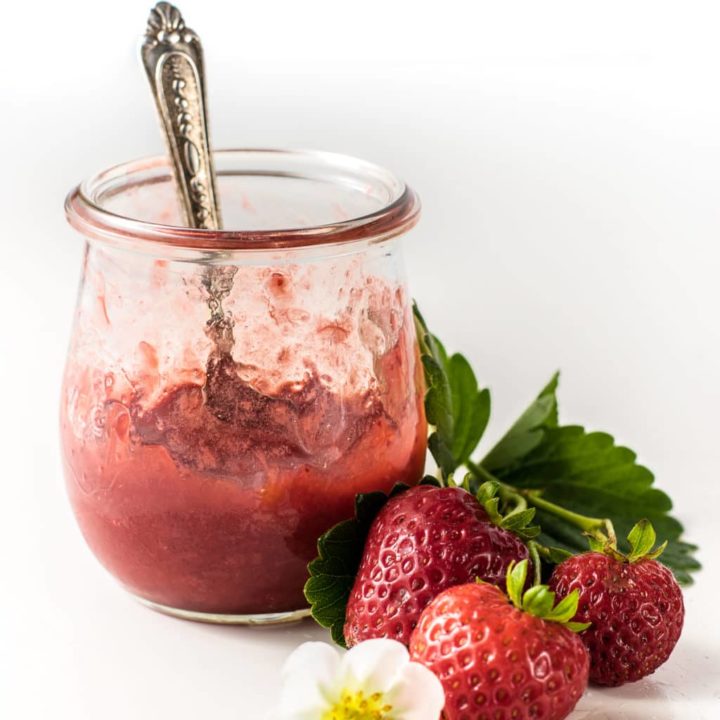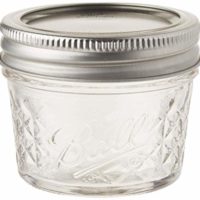No Added Sugar Strawberry Jam – All the Taste Without the Carbs (Shelf Stable!)
So I made several jams these past few weeks to stock and filled my pantry for the winter. I have a few favorites, but this sugar-free strawberry jam is, by far, my #1 favorite. I used my fresh garden strawberries, and I think that made the difference. It’s sweet and punchy and tastes like fresh strawberries with a tiny hint of burnt sugar. I’ve been smearing it on everything.
You don’t need garden-fresh strawberries though, you can make this jam with a frozen bag of strawberries.
There is no added sugar in this recipe, only the natural sugar from the fruit.

Oh the ways you can use this sugar-free strawberry jam
This sugar-free strawberry jam is super versatile.
Think of it as a strawberry filling.
I’m in the process of creating a few recipes with this jam, like low carb lamingtons, and some gluten-free PB&J cupcakes. But you could add this to anything where you want a punch of strawberry flavor.
Having a few jars on hand is a time saver. Making your jam also allows you to control the ingredients and level of sweetener in your jams. This process is a big win-win for me.
PLUS making your own shelf-stable strawberry jam is a great way to save a few bucks.

We’re using a 100% pectin without added sugar, for a perfect gel.
Ok so now let us talk about the pectin problem.
Pectin gets a bad wrap in the low carb/ keto food community. You will often see recipes say “made without pectin,” and that’s usually because the low sugar required pectins still have sugar in them.
So what do we do?
Well, I found this amazing product called Pomona’s 100% Pure Pectin. This post isn’t sponsored. I am over the moon crazy for this product.
No sugar is required, but you do need to use a sweetener. Stevia, xylitol, erythritol, monk fruit, allulose – it doesn’t matter, it will work. I tested ALL of them to see what sugar replacement would work best, and they all worked exceptionally well.

PomoNa’s 100% pectin
So if you have canned jam before, this process has an extra step.
The package of pectin also comes with a small packet of calcium powder.
There are two types of pectins – pectins that require sugar to gel, and pectins that need calcium to gel. There is a whole scientific explanation on Pomona’s website if you’re interested,
The calcium powder gets mixed into a small jar of water (and lasts forever refrigerated). The calcium water is what gets added to your jam recipes, usually a teaspoon or two at a time.
SO easy.
You can find Pomona’s pectin on Amazon, or in health food stores. I paid a little over $8.00 Canadian for a box. I balked at the price but did not realize that one box will make up to 22 half-pins (8 ounces) jars.
And you know what… with commercial low sugar jams priced high, it’s still way cheaper to make your own. Especially if you can get your hands on local, in-season berries.

Working with PomoNa’s 100% pectin
I found working with this pectin much easier vs. working with regular pectin. This pectin was much more forgiving. If the jam didn’t gel to my requirements, I could add more calcium water, and it would thicken a bit more.
If I added my pectin and sweetener, I could always add more sweetener and continue to process without over thickening the jam. This was great because I wanted to make sure my jam was sweet enough, but I didn’t want to over-sweeten at the start.
Additionally, If you have jars of jam that don’t quite set after they are cooled, you can reprocess them and add either more pectin or more calcium water to get the gel to thicken.
The instructions come in the box, and they are super easy to follow. Pomona’s also has a fantastic website with all kinds of directions and base recipes for you to work with including instructions for developing your own recipes.
- Quick note: Use filtered water in your recipes. If you have hard water (which tends to lean heavy on the calcium already), they will thicken more than you want them to – so be mindful that your water can play a part in how thick your jam gels.

What are the best sweeteners for this low carb strawberry jam recipe?
I tested them all! My kitchen will be forever sticky after this jam making session.
I tested Stevia (which I am not a fan of in the first place, but for testing, I gave it a whirl), Swerve, xylitol, erythritol, monk fruit/erythritol blend, allulose, and Truvia. They all worked beautifully, but some stood out above the rest.
By far the jam made with Allulose was the best. It had a sticky, gooey texture that commercially bottled jams are known for, and had the best taste. It straight up tasted like jam. By far, my favorite.
Erythritol did tend to turn grainy when cold, as erythritol tends to do. If you warmed the jam up, it was perfect. So if you want to use erythritol know that graining up when cold will happen.
I also tested my favorite sweetener, So Nourished monk fruit erythritol blend, and it did grain up a tiny bit but not as much as straight-up erythritol in the recipe.
Xylitol was GREAT, but it does add additional carbs, so not my favorite for that reason.
Truvia, Stevia, and Swerve worked fine, but I find they have an aftertaste for me, but that’s personal. If you like Truvia, or Stevia, or Swerve, absolutely use them. The jam gelled beautifully, and the fruit held the colour and texture.
****If you use Xylitol, remember that it is poisonous to dogs and cats! ****

Important Canning Tips
There are a few safety precautions!
This sugar-free strawberry jam requires a full 10-minute rolling boil to seal the jam jars – DO NOT skip this!
- DO NOT skip the lemon juice. I usually say fresh lemon juice at every opportunity, but canning is different. Use bottled lemon juice. Fresh lemons vary in acidity, and you want to make sure you get your acidity level correct. Using bottled lemon juice will ensure you’re adding the right amount. Strawberries are lower in acid, so the addition of lemon juice is required to get the PH levels correct for canning.
- Do not use a jam bottle larger that 500ML (2 cups).
- When you pull your sugar-free strawberry jam bottles from the canning bath, leave them rest for 24 hours without moving them, or tilting them. Let them set.
- Any jars that did not pop or did not seal properly can be reprocessed in the water bath for another 10 minutes, or stored in the refrigerator for up to 3 weeks.

Storage and Serving suggestions
After canning, this sugar-free strawberry jam stores well for up to a year in a cool dark place. Once opened, you can store this jam in the fridge for up to 3 weeks.
I suggest using smaller canning jars, like 4 ounces (half cup) so when you open your jar, you only have a few servings at a time in the fridge.
Of course, if you bake a lot, canning your jam in 8-ounce jars makes sense. Eight ounces is the perfect size to top a cheesecake or add as a filling to squares or bars.

Looking for More Sugar Free Jam Recipes?
Check out these sugar free and low carb jam and sauce recipes:

Laura Kennedy
Writer, Recipe Developer, and Blog Owner
With decades of experience in low-carb baking, Sugar-Free Sprinkles has been whipping up guilt-free treats long before keto became a trend. Her recipes have been featured in Prevention Magazine, Women’s Health, Woman’s Day, Taste of Home, and The Pioneer Woman — to name a few!

Sugar-Free Strawberry Jam - All the Taste Without the Carbs (shelf stable!)
A sugar-free strawberry jam that gels perfectly and is shelf-stable for up to a year. Perfect for adding to low carb baking recipes for a punch of strawberry flavor.
Ingredients
- 5 cups fresh chopped strawberries
- 1/4 cup lemon juice
- 1 1/3 cup allulose
- 2 tsp Pomona's Universal Pectin
- 2 tsp calcium water (provided in the pectin box)
- 1 tsp vanilla (optional)
Instructions
- Wash jars, bands, and lids in hot soapy water. Place jars in water bath canner filled 1/2 way with water. Bring water to a rolling boil. Turn off the burner and leave jars in canner until ready to use.
- Place lids and bands in water in a small saucepan and heat until water simmers. Keep lids & bands in warm water until ready to use.
- If using fresh strawberries, chop into quarters before adding to a large saucepan. If using frozen measure 6 cups and add to your saucepan.
- Add lemon juice, vanilla and calcium water to strawberries and blend in well.
- In a bowl add allulose and pectin and blend well.
- Heat the strawberries in the saucepan over medium heat. As they start to soften, mash with the back of a fork, or use a potato masher. I like my jam to be a bit chunky so I only mash a little bit. Mash your strawberries to the consistency that you like. Bring strawberries to a boil.
- Add pectin-sweetener mixture, continuing to mix for 1 to 2 minutes to dissolve the pectin while the strawberry jam comes back up to a boil. Boil for 1 full minute once the jam reaches the boiling stage.
- Fill jam jars to ¼” to the top. Clean rims with a clean cloth. Add lids and twist bands until finger tight.
- Add jars to the water bath canner when the water in the canner reaches a full boil. Boil 10 full minutes (add 1 minute more for every 1,000 ft. above sea level).
- Remove from water. Let jars cool undisturbed for 24 hours.
- Test for seal, if a jar did not seal, you can reprocess it again in the canner for 10 full minutes, or add that jar to the refrigerator for up to 3 weeks.
- If your strawberry jam did not gel to the consistency you want you can add the jam back into a saucepan and add another tsp of calcium water. Bring the jam back up to a boil and repeat steps 8 to 11.
Notes
You control the level of sweetness in this recipe. If you want to add half the sweetener, that is perfectly fine. If you want to add more, that will also work. The level of sweetener does not impact the gel from this pectin.
The jam is shelf-stable unopened for up to one year so long as the jam is stored in a cool dark place. Once opened, the jam will need to be refrigerated and will last for a week.
Serving size is one tablespoon
Recommended Products
As an Amazon Associate and member of other affiliate programs, I earn from qualifying purchases.
Nutrition Information:
Yield: 80 Serving Size: 1Amount Per Serving: Calories: 4Total Fat: 0gSaturated Fat: 0gTrans Fat: 0gUnsaturated Fat: 0gCholesterol: 0mgSodium: 1mgCarbohydrates: 1gNet Carbohydrates: 1gFiber: 0gSugar: 1gSugar Alcohols: 9gProtein: 0g
Nutritional information for the recipe is provided as a courtesy and is approximate only. We cannot guarantee the accuracy of the nutritional information given for any recipe on this site. Erythritol carbs (and sugar alcohols) are not included in carb counts as it has been shown not to impact blood sugar. Net carbs are the total carbs minus fibre.


















